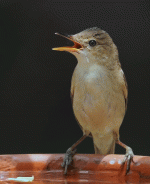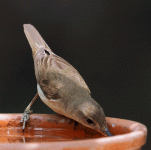I dont believe this is a Marsh warbler as there are several points wrong / unusual for this species:
The claws are so dark and blackish.
The upperparts (especially the back) are unusally grey for a Marsh warbler, even for a worn bird (although I have never seen a bird that lacks yellow/green pigments which can theoretically occur).
The few greyish worn Marsh (yes I know they exist!) in I saw western Europe looked like this:
http://uearg.blogspot.de/2011/08/marsh-warbler-at-whitlingham.html or
http://www.club300.de/gallery/photo.php?id=53262 or
http://www.rarebirdspain.net/arbsr904.htm (note the difference in colour against your bird, but I must admit that I have never been in the Middle East, do Marsh Wablers look different there, because of wear and bleaching? )
The tertials are to pale and plain even for such worn feathers.
Another thing: the iris looks unusally colorless (pale grey) for a Marsh warbler.
So my question is: do the pictures show the correct colours as perceived in the field?
I cant help, but the tertials look to broad, short and rounded for a Marsh warbler (and also for European Reed Warbler). I know, this isnt a field mark. But if you imagine this picture is a quizbird (with expensive prizes like an alpha binocular or a birding holiday) and you think that Marsh warbler is the right answer, than this detail would you hesitate to send the answer and rethink the identification. See what I mean?
The primary spacing seems to tight for a TYPICAL Marsh warbler, making the wingtip seems bunched together. But im not an expert for the variation of this character.
I dont think the undertailcoverts can be properly assesed in the picture, but i dont think they look full enough to exclude an Hippolais warbler.
There is a difference in proportions (mentioned for example in Bub and Dorsch: Kennzeichen und Mauser europäischer Singvögel 1988): Reed is a smaller bird with bigger feet while Marsh is a bigger bird with smaller feet). I havent been able to find this difference in the field, but very very very rarely I found birds where I thought: this bird has so large feet, this might be a Reed and not a Marsh. Your bird is an example of this.
So what is it? I havent experience with the relevant taxa in the Middle East, I just wanted to say that for me the bird doesnt look like a Marsh warbler
Greetings,
Alexander Stöhr






